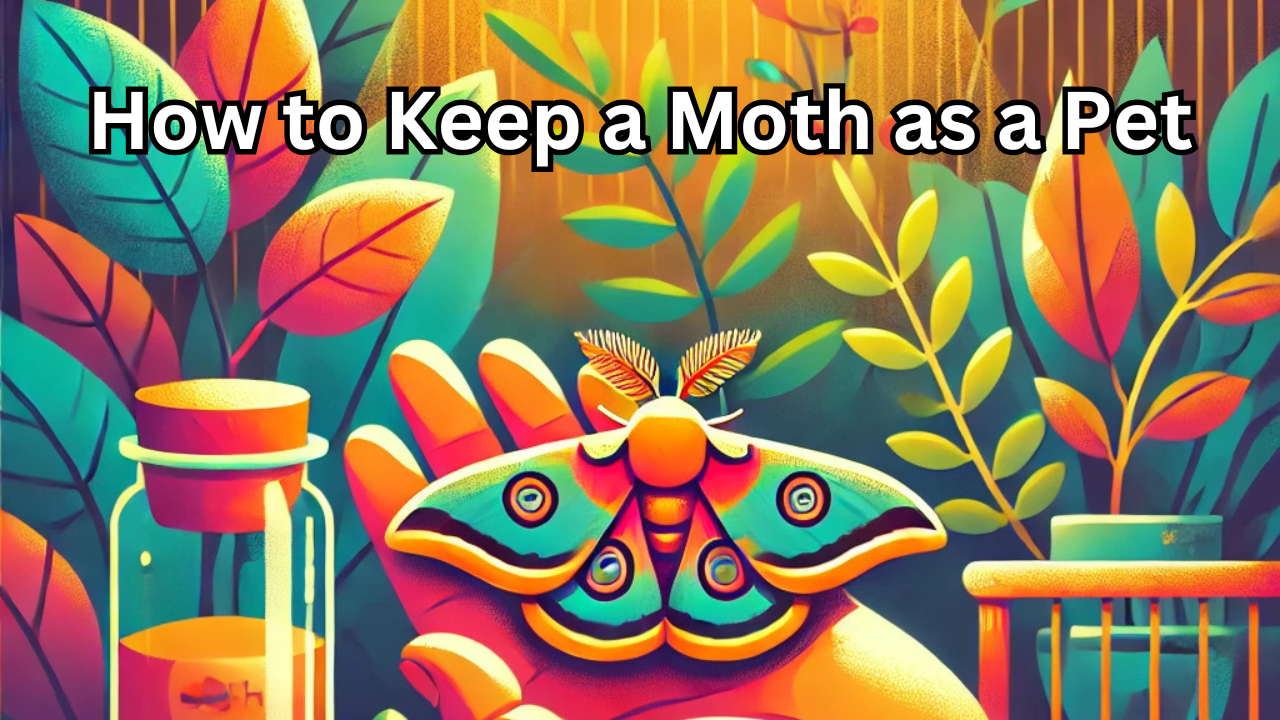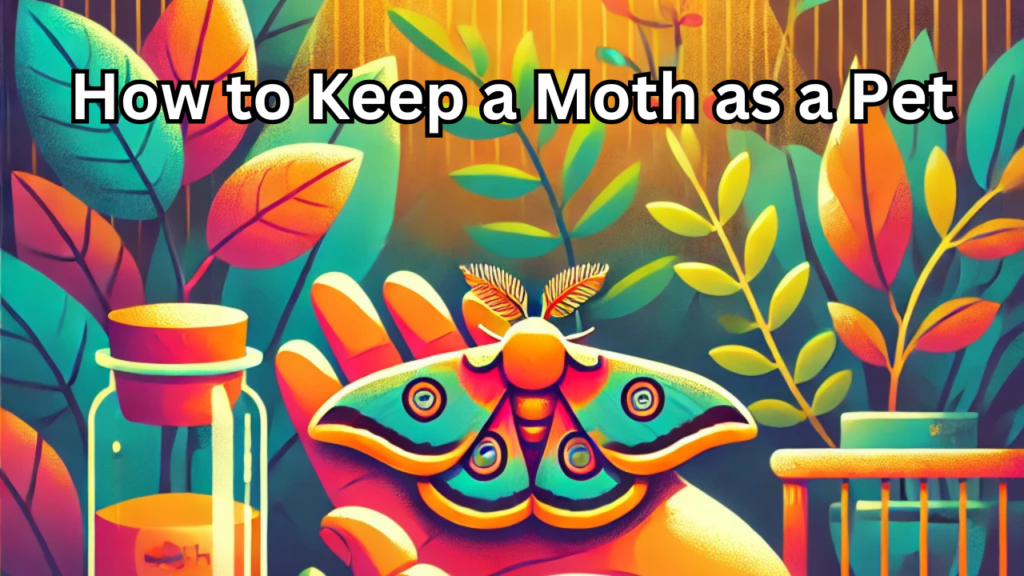

Table of Contents
Introduction
Keeping moths as pets may not be the first idea that comes to mind when thinking about household companions, but it’s a trend growing in popularity among nature enthusiasts. These delicate, nocturnal creatures captivate with their mesmerizing patterns, unique life cycles, and quiet elegance. Unlike traditional pets, moths are low-maintenance and offer a fascinating glimpse into the insect world, making them a perfect choice for those with a passion for observing nature up close.
For individuals in regions like New Jersey and New York, where moth enthusiasts are on the rise, the appeal lies in the diversity of species native to the area. From the striking Luna moth to the impressive Cecropia, local ecosystems offer a variety of moths that can be raised and cared for responsibly.
In this guide on how to keep a moth as a pet, we’ll explore everything you need to know to begin your journey with these enchanting insects. From creating a suitable habitat to understanding their dietary needs, you’ll discover how to ensure your pet moth thrives in its new environment.
Why Choose a Moth as a Pet?
Moths are a unique and often underrated choice for anyone looking to connect with nature on a deeper level. Unlike traditional pets and animals, moths bring a quiet charm and an opportunity to appreciate the intricacies of the insect world. Whether you’re a nature enthusiast or simply curious about trying something different, keeping a moth as a pet offers a fascinating and rewarding experience.
One of the biggest advantages of keeping a moth is how easy they are to care for. These insects require minimal space, making them ideal for individuals with limited room or those looking for a low-maintenance pet. A small enclosure with the right conditions is all it takes to keep your pet moth healthy and thriving.
Beyond practicality, moths are aesthetically stunning creatures. Species like the Luna moth, with its pale green wings and delicate tail-like extensions, are true works of art in nature. Watching a moth’s lifecycle unfold—from egg to caterpillar, pupa, and finally an adult moth—is an awe-inspiring experience that adds a sense of wonder to your home.
If you’re curious about how to keep a moth as a pet, rest assured that it’s a straightforward and rewarding process. With the right habitat setup, proper nutrition, and a little patience, you can enjoy the beauty and serenity of these incredible creatures in your care.
Best Pet Moths to Consider
If you’re considering keeping a moth as a pet, some species stand out for their beauty, ease of care, and fascinating lifecycles. Here are the best pet moths to start your journey, along with insights into their unique features and care requirements.
1. Luna Moth (Actias luna)
Known for its ethereal green wings and iconic tail-like extensions, the Luna moth is a favorite among enthusiasts. As a Luna moth pet, it provides a serene and visually stunning addition to your home. However, their adult stage is short, with a pet moth lifespan of only about a week, as they do not eat during this time. Ensuring their habitat includes suitable plants for laying eggs can prolong your engagement with their lifecycle.
2. Atlas Moth (Attacus atlas)
The Atlas moth is one of the largest moths in the world, boasting strikingly patterned wings. While their size requires a larger enclosure, they are relatively easy to care for as they are primarily sedentary in their adult stage. With a pet moth lifespan of around one to two weeks as adults, their care focuses more on the pupal and larval stages.
3. Polyphemus Moth (Antheraea polyphemus)
The Polyphemus moth, named for the eye-like spots on its wings, is another excellent option. These moths are docile and easy to handle, with a short lifespan of about a week in their adult phase. Their caterpillars are known for their vibrant green color and impressive size, offering an engaging experience throughout their lifecycle.
4. Silk Moth (Bombyx mori)
Domesticated for centuries, the Silk moth is a beginner-friendly choice. They are smaller and easier to house compared to larger species. Their lifecycle is predictable, making them ideal for observing metamorphosis. While their adult stage lasts only a few days, their caterpillars are active and require mulberry leaves for sustenance.
Each of these species offers a unique way to connect with nature and appreciate the delicate beauty of moths. By understanding the specific needs of your chosen pet moth, from providing the right enclosure to supporting their dietary requirements, you can enjoy a rewarding experience with these fascinating insects.
How to Set Up a Habitat for Your Moth
Creating a comfortable and safe habitat is crucial when learning how to keep a moth as a pet in the house. Moths require minimal space but need specific conditions to thrive. Here’s a step-by-step guide to setting up the perfect environment for your pet moth.
Choosing the Right Enclosure
Start by selecting an enclosure that suits your moth’s size and needs. A jar, small terrarium, or mesh cage can work well. If you’re wondering how to keep a moth alive in a jar, ensure the jar is large enough to allow free movement and includes small air holes for ventilation. For larger species, a terrarium or mesh cage provides ample space and airflow.
Ventilation and Safety Considerations
Proper ventilation is essential to prevent moisture buildup and maintain a healthy environment. When keeping a moth in a jar, cover the opening with a breathable material like mesh or fine cloth to allow air circulation while keeping your moth secure. For homes near nature-rich areas like New Jersey, be cautious of local predators or environmental changes that may affect your moth.
Adding Plants and Structures
Moths feel most comfortable in environments that mimic their natural habitat. Add small branches or sticks to give them a place to perch or hang during their resting phase. Soft surfaces, like paper towels or moss, can line the bottom of the enclosure for added comfort. Including plants or leaves, especially those suitable for the caterpillar stage, enhances the habitat’s functionality and aesthetics.
By following these steps, you’ll create a safe and inviting space for your moth, whether you’re raising it from the caterpillar stage or caring for it as an adult. Understanding how to keep a moth as a pet near New Jersey involves paying attention to local species’ needs and providing an environment that allows them to thrive indoors.
What Do Moths Eat?
Understanding what do moths eat is essential for providing proper care and ensuring their well-being as pets. While moths in their adult stage often have simple dietary needs, their earlier life stages, like caterpillars, may require specific plants or leaves to thrive. Here’s a detailed look at moth diets and feeding tips for your pet.
Adult Moth Diets
Most adult moths consume nectar from flowers, much like butterflies. They use their proboscis—a tube-like mouthpart—to sip liquid food. For pet moths, you can mimic this natural diet by offering diluted honey water, fruit juices, or sugar water. Simply soak a cotton ball in the liquid and place it in their enclosure. This setup allows them to feed easily without making a mess.
If you’re wondering, “What can I feed a moth?”, other options include small slices of overripe fruit like bananas, oranges, or apples. The sugary content provides energy, ensuring your moth remains active and healthy during its short lifespan.
Caterpillar Diets
If you’re raising a moth from the caterpillar stage, the diet will depend on the species. Caterpillars are highly specific in their food preferences, often feeding on particular plants. For example, Silk moth caterpillars require mulberry leaves, while Polyphemus moth caterpillars feed on oak, maple, or birch leaves. Always research the specific dietary needs of your pet moth species.
Feeding Tips for Pet Moths
- Refresh food and water sources daily to prevent spoilage.
- Ensure food placement is accessible but not overcrowded to keep the habitat clean.
- Avoid strong-smelling or artificially flavored fruits and liquids, as these can deter moths from feeding.
Knowing what do moths eat and providing the right food sources can enhance their quality of life and ensure their health. Whether you’re caring for an adult moth sipping nectar or a hungry caterpillar devouring leaves, understanding their dietary needs is a rewarding part of keeping these fascinating creatures as pets.
Caring for a Moth: Daily and Long-Term Tips
Once you’ve set up the perfect habitat, proper care is essential to ensure your moth thrives. Learning how to keep a moth as a pet involves simple but consistent daily and long-term maintenance to create a safe, comfortable environment for your delicate companion.
Daily Care Tips
- Monitor Cleanliness
Check the enclosure daily for waste, leftover food, or excess moisture. Cleanliness prevents mold growth and keeps your moth healthy. Remove uneaten fruit slices or cotton balls soaked in honey water to avoid attracting pests. - Check Comfort Levels
Ensure the habitat mimics a moth’s natural environment. Moths need soft surfaces and branches to rest comfortably. Keeping their resting areas clean and unobstructed helps them feel secure. - Humidity and Hydration
Maintaining the right humidity is crucial, especially for species that require a specific climate. Lightly misting the enclosure with water can help create a balanced environment, but be careful not to oversaturate it.
Long-Term Care Tips
- Temperature Management
Most moths thrive in moderate temperatures, typically between 65°F and 75°F. Keep their habitat away from direct sunlight, cold drafts, or sudden temperature changes. This is particularly important for those raising moths in areas like New Jersey, where weather fluctuations are common. - Provide Adequate Space
To ensure your moth remains active and stress-free, the enclosure must be spacious enough for them to spread their wings and move around. Crowded or cramped conditions can damage their delicate wings, impacting their ability to perch or fly. - Observe and Adapt
Regularly observe your moth to understand its behavior and preferences. Each species may have unique needs, so be prepared to adapt your care routine accordingly.
By following these tips, you’ll master how to keep a moth as a pet, providing a nurturing environment that supports their short but fascinating life. Consistent care not only keeps your moth healthy but also enhances the joy of observing and interacting with these enchanting creatures.
Where to Find Pet Moths
When looking for a pet moth, it’s essential to source them responsibly to protect both the environment and the moth species. Whether you’re exploring nature, shopping locally, or purchasing online, here are some tips to find pet moths for sale while ensuring ethical practices.
Ethical Sourcing from Nature
For those wondering how to keep a moth as a pet near New York, NY, local parks and gardens are a great place to start. Areas around New York and New Jersey host a variety of moth species, such as the Luna moth or Polyphemus moth. Collecting eggs or caterpillars from plants is an ethical option, as long as you avoid disrupting their natural habitat. Be sure to leave enough behind to maintain the ecosystem’s balance.
Local Pet Stores and Breeders
In regions like New York and New Jersey, some specialty pet stores or breeders may have pet moths for sale. These sellers often provide healthy moths or caterpillars, along with information about their care and habitat needs. Always inquire about the source to ensure the moths have been bred ethically and not taken directly from the wild.
Online Sources and Forums
The internet offers a convenient way to find specific moth species. Many websites and forums cater to insect enthusiasts, listing pet moths for sale along with care guidelines. Reputable platforms like insect hobbyist forums or specialized breeders can provide moths or caterpillars shipped to your location. Examples include sites specializing in Luna moths or Atlas moths, ideal for those curious about how to keep a moth as a pet near New York, NY.
When purchasing online, verify the seller’s reviews and policies. Look for breeders who prioritize the health of their insects and comply with local regulations.
By sourcing your moth ethically—whether from nature, local sellers, or online—you can enjoy the unique experience of raising a pet moth while respecting the environment.
Common Challenges and Solutions
Raising moths as pets can be a rewarding experience, but it comes with unique challenges. Understanding and addressing these issues will help you master how to keep a moth as a pet and ensure their well-being.
Challenge 1: Short Lifespan
Moths in their adult stage often have a brief life, typically lasting only a few days to a week. While this can be disheartening, you can make the most of their time by observing their behavior, providing a comfortable habitat, and ensuring they have proper nutrition, like honey water or fruit slices. If you’re raising them from the caterpillar stage, the full lifecycle offers weeks of engagement and learning.
Solution: Embrace the lifecycle of your pet moth as part of the experience. Use their short lifespan to observe their fascinating transformation, from caterpillar to cocoon to adult. Consider raising multiple moths to extend your enjoyment over time.
Challenge 2: Safe Handling
Moths have delicate wings covered in tiny scales, which can easily be damaged if mishandled. Improper handling can hinder their ability to fly and rest comfortably.
Solution: Always handle your moth gently, avoiding direct contact with their wings. If you need to move them, use a soft brush or allow them to climb onto your hand. Providing branches or other perching surfaces in their enclosure reduces the need for frequent handling.
Challenge 3: Mold and Pests in the Enclosure
Mold and pests can quickly develop in humid environments, especially when food or moisture isn’t managed properly. This can harm your moth’s health and compromise their living space.
Solution: Maintain the enclosure by cleaning it daily, removing uneaten food and excess moisture. Ensure proper ventilation to prevent mold growth, and avoid overcrowding the habitat. If pests are detected, thoroughly clean and sanitize the enclosure before reintroducing your moth.
By addressing these common challenges, you’ll gain confidence in how to keep a moth as a pet, creating a safe and enjoyable environment for these fascinating creatures.
Conclusion
Keeping a moth as a pet is a unique and rewarding experience that allows you to connect with nature in a special way. By following the key steps outlined in this guide—creating a suitable habitat, understanding their dietary needs, and addressing common challenges—you can master how to keep a moth as a pet and ensure their well-being.
Whether you’re captivated by the ethereal beauty of a Luna moth or intrigued by the lifecycle of a Silk moth, raising these delicate creatures offers an opportunity to appreciate their fascinating world. With minimal care requirements and a chance to observe nature up close, this hobby is perfect for anyone looking for a low-maintenance yet fulfilling pet experience.
As you embark on this journey, remember the importance of being a responsible moth owner. Source your moths ethically, provide a safe and clean habitat, and handle them gently to protect their delicate wings. By doing so, you’ll not only enjoy their presence but also contribute to the appreciation and conservation of these remarkable insects.
Start your adventure today and discover the joy of learning how to keep a moth as a pet—a hobby that brings wonder, beauty, and a touch of the extraordinary into your home.
FAQs About Keeping Moths as Pets
For those curious about how to keep a moth as a pet, here are answers to some frequently asked questions to help guide your journey as a moth owner.
Can moths be domesticated?
Moths cannot be domesticated in the traditional sense, as they remain wild insects. However, they can adapt to a controlled environment if their basic needs—such as food, space, and temperature—are met. Raising moths from caterpillars can provide a unique bond as you watch them complete their lifecycle.
How long do pet moths live?
The lifespan of a pet moth varies by species and stage of life. Adult moths typically live for a few days to a week, while their caterpillar and pupal stages can last several weeks or even months. For example, a Luna moth pet may live only a few days as an adult, focusing on reproduction during that time.
Can I keep a moth I find outside as a pet?
Yes, you can keep a moth found outside, but it’s essential to handle it gently and ensure you can meet its needs. Before bringing it home, research the species to understand its dietary and habitat requirements. Be cautious when collecting wild moths, especially in protected areas like those in New York and New Jersey, to ensure ethical practices.
Do moths recognize their owners?
Moths do not recognize their owners in the way mammals or birds might. Their behaviors are instinct-driven rather than based on social bonding. However, caring for a moth and observing its lifecycle can still be a rewarding experience for you as an owner.
What types of moths are safe to keep at home?
Species like the Luna moth, Polyphemus moth, Atlas moth, and Silk moth are popular choices for pet enthusiasts. These moths are large, visually striking, and relatively easy to care for, making them ideal for beginners learning how to keep a moth as a pet.
Is it ethical to keep moths as pets?
It can be ethical to keep moths as pets if they are sourced responsibly. Raising moths from caterpillars or purchasing them from reputable breeders ensures minimal impact on wild populations. Avoid taking moths or eggs from protected areas or disrupting local ecosystems.
Can moths lay eggs in captivity?
Yes, moths can lay eggs in captivity if the environment mimics their natural conditions. Female moths may deposit eggs on suitable surfaces or plants within the enclosure. If you’re interested in raising more moths, ensure you have the resources to care for the caterpillars that will hatch.
By understanding these common questions, you’ll gain deeper insights into how to keep a moth as a pet and enjoy a fascinating connection with these delicate creatures.





